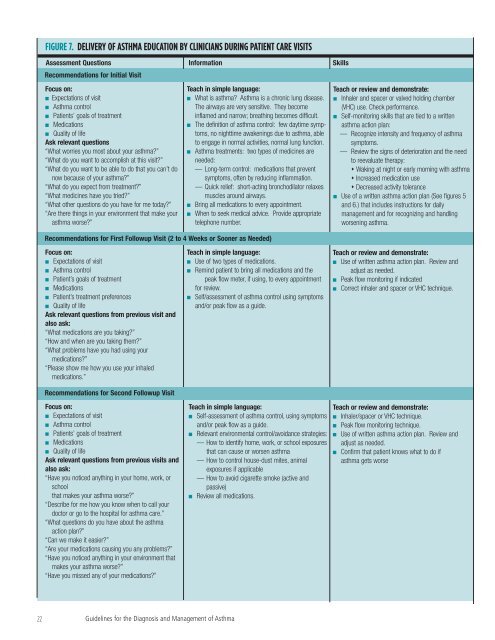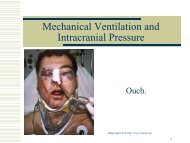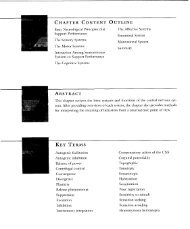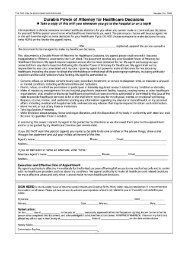Guidelines for the Diagnosis and Management of Asthma
Guidelines for the Diagnosis and Management of Asthma
Guidelines for the Diagnosis and Management of Asthma
You also want an ePaper? Increase the reach of your titles
YUMPU automatically turns print PDFs into web optimized ePapers that Google loves.
FIGURE 7. DELIVERY OF ASTHMA EDUCATION BY CLINICIANS DURING PATIENT CARE VISITS<br />
Assessment Questions In<strong>for</strong>mation Skills<br />
Recommendations <strong>for</strong> Initial Visit<br />
Focus on:<br />
■ Expectations <strong>of</strong> visit<br />
■ <strong>Asthma</strong> control<br />
■ Patients’ goals <strong>of</strong> treatment<br />
■ Medications<br />
■ Quality <strong>of</strong> life<br />
Ask relevant questions<br />
“What worries you most about your asthma?”<br />
“What do you want to accomplish at this visit?”<br />
“What do you want to be able to do that you can’t do<br />
now because <strong>of</strong> your asthma?”<br />
“What do you expect from treatment?”<br />
“What medicines have you tried?”<br />
“What o<strong>the</strong>r questions do you have <strong>for</strong> me today?”<br />
“Are <strong>the</strong>re things in your environment that make your<br />
asthma worse?”<br />
Teach in simple language:<br />
■ What is asthma? <strong>Asthma</strong> is a chronic lung disease.<br />
The airways are very sensitive. They become<br />
inflamed <strong>and</strong> narrow; breathing becomes difficult.<br />
■ The definition <strong>of</strong> asthma control: few daytime symptoms,<br />
no nighttime awakenings due to asthma, able<br />
to engage in normal activities, normal lung function.<br />
■ <strong>Asthma</strong> treatments: two types <strong>of</strong> medicines are<br />
needed:<br />
— Long-term control: medications that prevent<br />
symptoms, <strong>of</strong>ten by reducing inflammation.<br />
— Quick relief: short-acting bronchodilator relaxes<br />
muscles around airways.<br />
■ Bring all medications to every appointment.<br />
■ When to seek medical advice. Provide appropriate<br />
telephone number.<br />
Recommendations <strong>for</strong> First Followup Visit (2 to 4 Weeks or Sooner as Needed)<br />
Teach or review <strong>and</strong> demonstrate:<br />
■ Inhaler <strong>and</strong> spacer or valved holding chamber<br />
(VHC) use. Check per<strong>for</strong>mance.<br />
■ Self-monitoring skills that are tied to a written<br />
asthma action plan:<br />
— Recognize intensity <strong>and</strong> frequency <strong>of</strong> asthma<br />
symptoms.<br />
— Review <strong>the</strong> signs <strong>of</strong> deterioration <strong>and</strong> <strong>the</strong> need<br />
to reevaluate <strong>the</strong>rapy:<br />
Waking at night or early morning with asthma<br />
Increased medication use<br />
Decreased activity tolerance<br />
■ Use <strong>of</strong> a written asthma action plan (See figures 5<br />
<strong>and</strong> 6.) that includes instructions <strong>for</strong> daily<br />
management <strong>and</strong> <strong>for</strong> recognizing <strong>and</strong> h<strong>and</strong>ling<br />
worsening asthma.<br />
Focus on:<br />
■ Expectations <strong>of</strong> visit<br />
■ <strong>Asthma</strong> control<br />
■ Patient’s goals <strong>of</strong> treatment<br />
■ Medications<br />
■ Patient’s treatment preferences<br />
■ Quality <strong>of</strong> life<br />
Ask relevant questions from previous visit <strong>and</strong><br />
also ask:<br />
“What medications are you taking?”<br />
“How <strong>and</strong> when are you taking <strong>the</strong>m?”<br />
“What problems have you had using your<br />
medications?”<br />
“Please show me how you use your inhaled<br />
medications.”<br />
Recommendations <strong>for</strong> Second Followup Visit<br />
Focus on:<br />
■ Expectations <strong>of</strong> visit<br />
■ <strong>Asthma</strong> control<br />
■ Patients’ goals <strong>of</strong> treatment<br />
■ Medications<br />
■ Quality <strong>of</strong> life<br />
Ask relevant questions from previous visits <strong>and</strong><br />
also ask:<br />
“Have you noticed anything in your home, work, or<br />
school<br />
that makes your asthma worse?”<br />
“Describe <strong>for</strong> me how you know when to call your<br />
doctor or go to <strong>the</strong> hospital <strong>for</strong> asthma care.”<br />
“What questions do you have about <strong>the</strong> asthma<br />
action plan?”<br />
“Can we make it easier?”<br />
“Are your medications causing you any problems?”<br />
“Have you noticed anything in your environment that<br />
makes your asthma worse?”<br />
“Have you missed any <strong>of</strong> your medications?”<br />
Teach in simple language:<br />
■ Use <strong>of</strong> two types <strong>of</strong> medications.<br />
■ Remind patient to bring all medications <strong>and</strong> <strong>the</strong><br />
peak flow meter, if using, to every appointment<br />
<strong>for</strong> review.<br />
■ Self/assessment <strong>of</strong> asthma control using symptoms<br />
<strong>and</strong>/or peak flow as a guide.<br />
Teach in simple language:<br />
■ Self-assessment <strong>of</strong> asthma control, using symptoms<br />
<strong>and</strong>/or peak flow as a guide.<br />
■ Relevant environmental control/avoidance strategies:<br />
— How to identify home, work, or school exposures<br />
that can cause or worsen asthma<br />
— How to control house-dust mites, animal<br />
exposures if applicable<br />
— How to avoid cigarette smoke (active <strong>and</strong><br />
passive)<br />
■ Review all medications.<br />
Teach or review <strong>and</strong> demonstrate:<br />
■ Use <strong>of</strong> written asthma action plan. Review <strong>and</strong><br />
adjust as needed.<br />
■ Peak flow monitoring if indicated<br />
■ Correct inhaler <strong>and</strong> spacer or VHC technique.<br />
Teach or review <strong>and</strong> demonstrate:<br />
■ Inhaler/spacer or VHC technique.<br />
■ Peak flow monitoring technique.<br />
■ Use <strong>of</strong> written asthma action plan. Review <strong>and</strong><br />
adjust as needed.<br />
■ Confirm that patient knows what to do if<br />
asthma gets worse<br />
22 <strong>Guidelines</strong> <strong>for</strong> <strong>the</strong> <strong>Diagnosis</strong> <strong>and</strong> <strong>Management</strong> <strong>of</strong> <strong>Asthma</strong>





